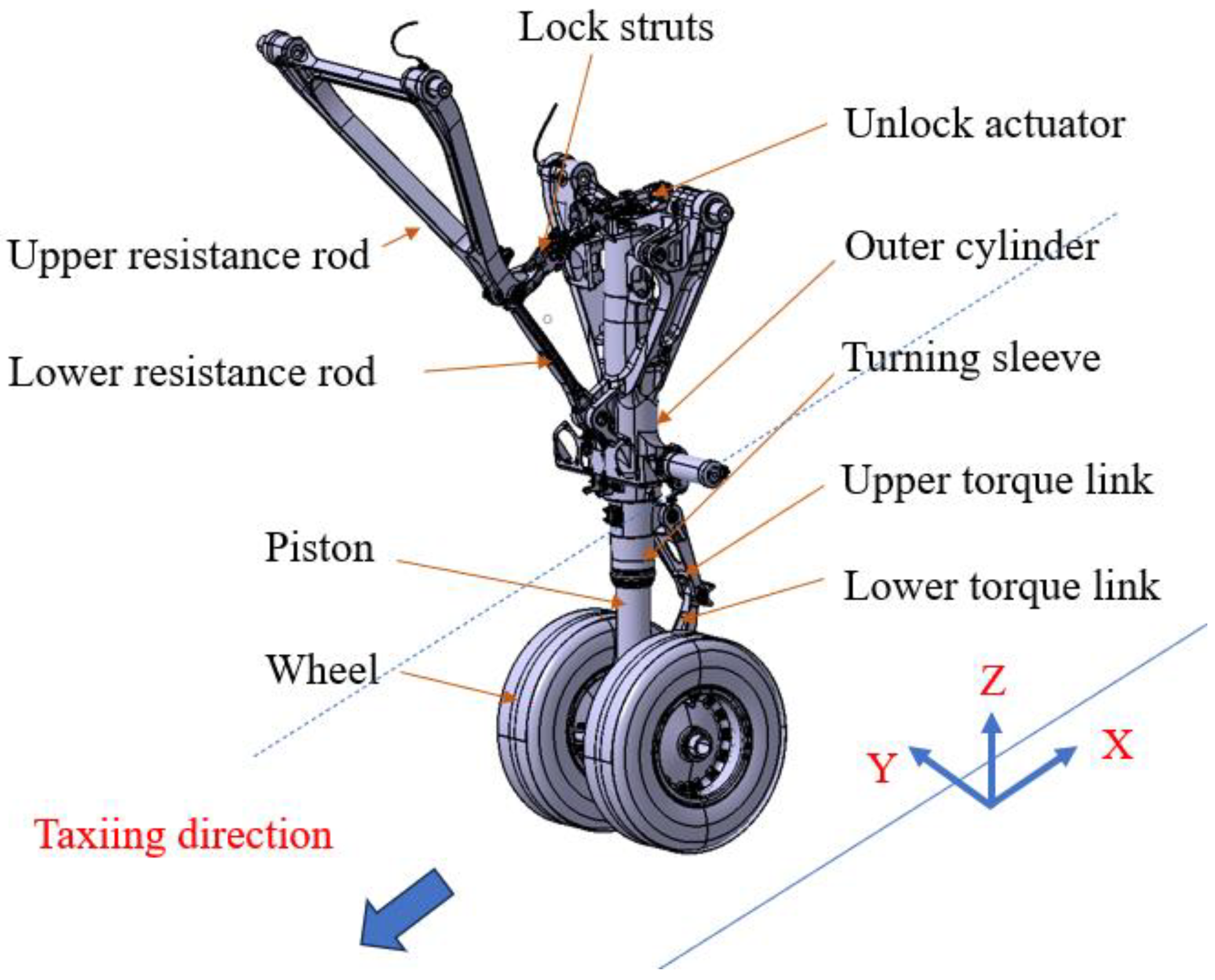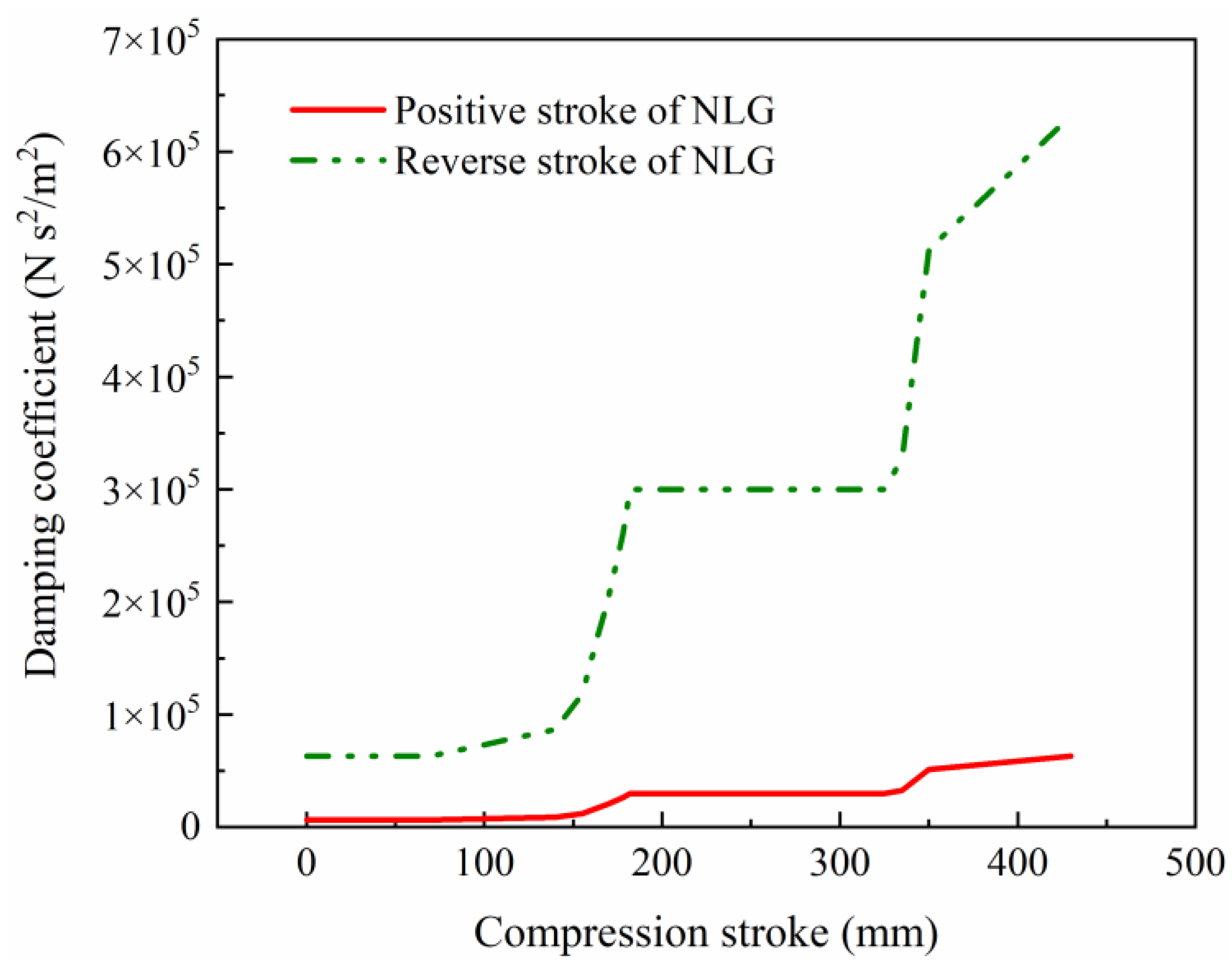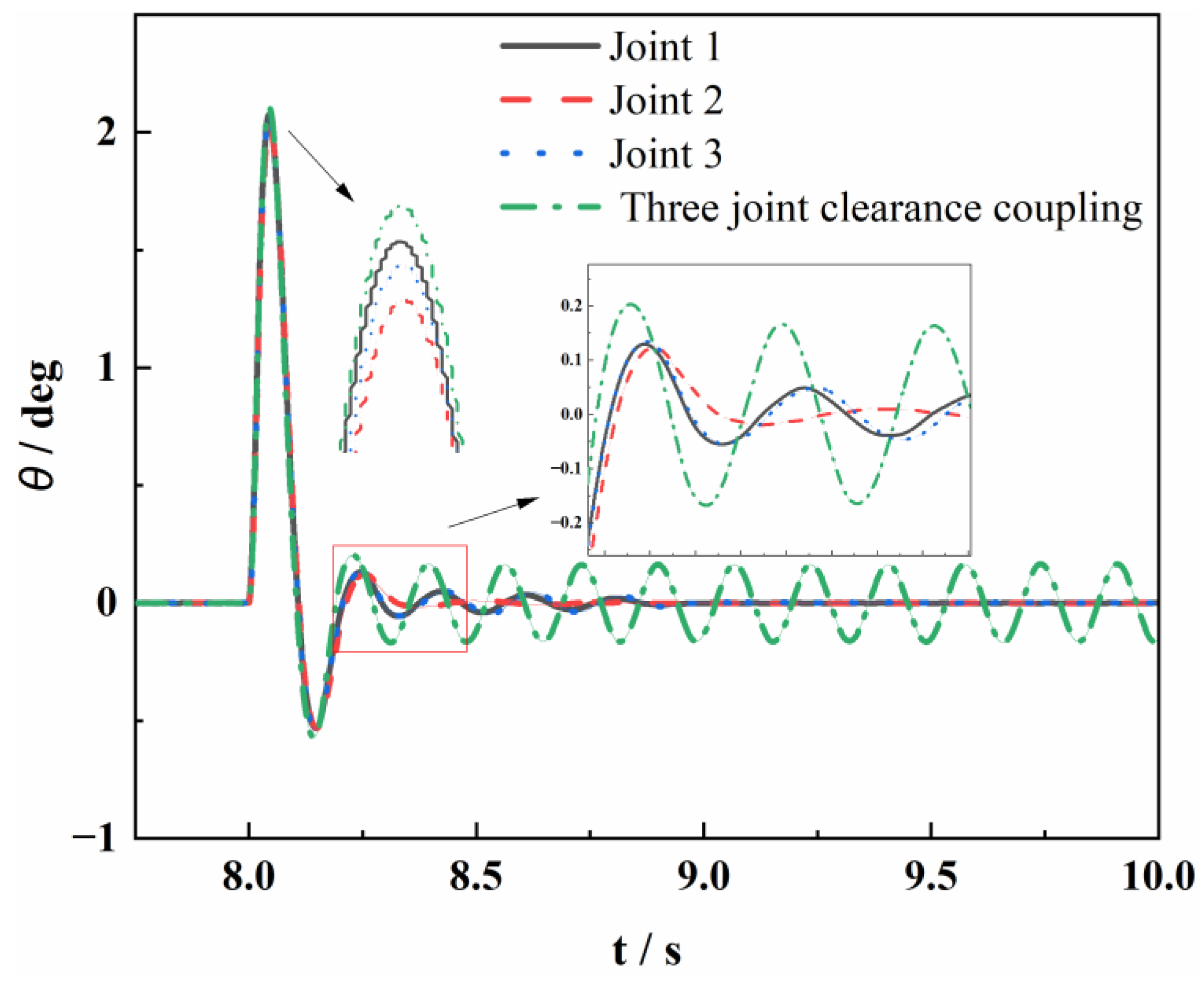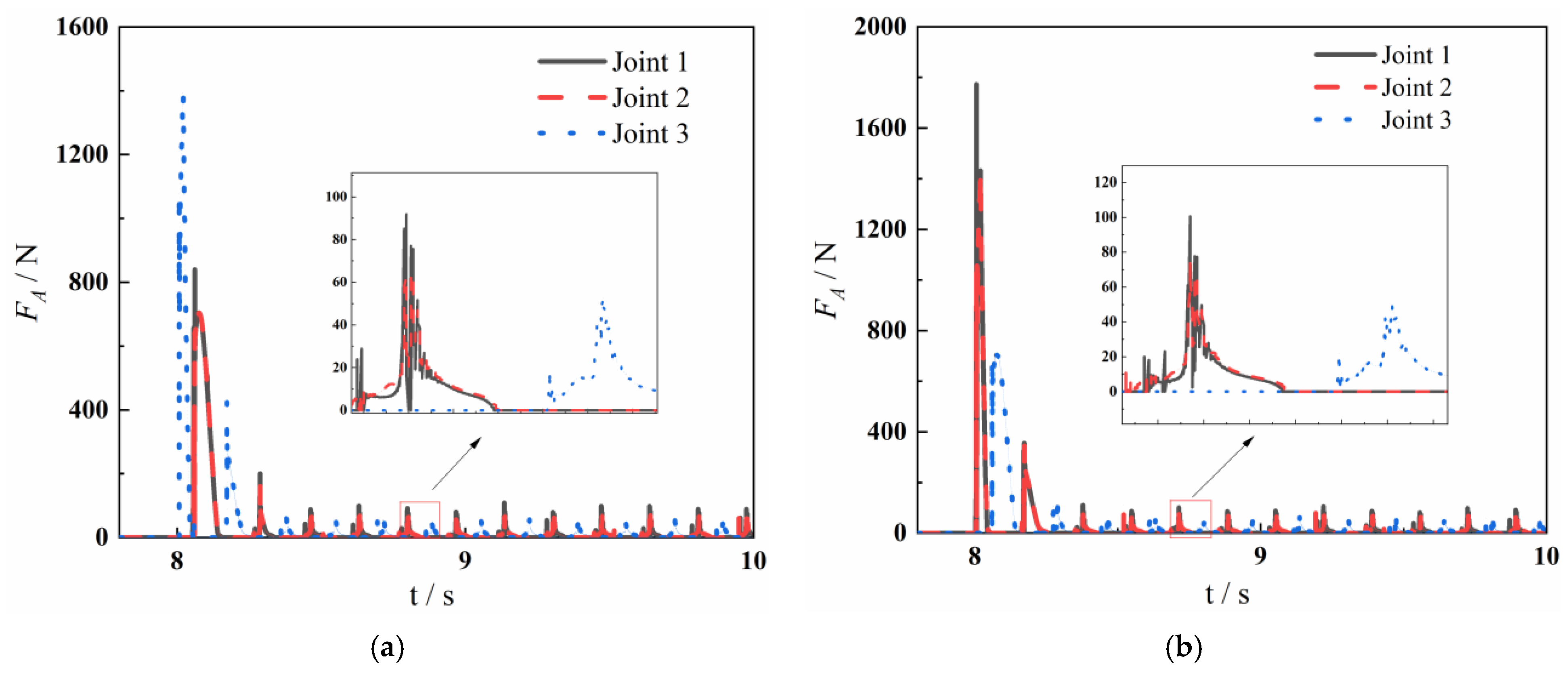Effect of Multi-Joint Clearance Coupling on Shimmy of Nose Landing Gear
Abstract
:1. Introduction
2. Multibody Dynamics Model of the NLG with Joint Clearance
2.1. Dynamic Equation of Multibody System
2.2. Simplified Model of NLG
2.3. Load Applied to NLG
2.4. Analysis of Joint Connection Form
2.5. Establishment of Equivalent Model of Joint Clearance
2.6. Simulation Model Parameters
3. Load Transfer Analysis of NLG with Joint Clearances
4. Shimmy Analysis of NLG with Multiple Joint Clearances
4.1. Influence of Taxiing Speed on Shimmy of NLG with Multiple Joint Clearances
4.2. Impact of Multiple Joint Wear on the Shimmy of NLG
4.3. Influence of Shimmy Damper Damping on Shimmy of NLG with Multiple Clearances
5. Conclusions
- Multiple joint clearances increase the occurrences of axial contact collisions and result in increased wear. During the occurrence of oscillations, the axial contact force transmission at the three joint positions follows a same-side path at joint 1 and joint 2, while it follows an opposite-side path at joint 3. The radial and axial contact force of the joint is the largest at joint 1 and the smallest at joint 3, and the radial contact forces are higher at the ends of the connecting shafts, leading to uneven wear of the shafts and bushings.
- Joint clearances cause periodic oscillations of the NLG’s front wheel. With increasing taxiing speed, the amplitude of periodic oscillations shows an increasing trend within the range of 10 to 30 m/s, while it shows a decreasing trend within the range of 30 to 90 m/s. When the damping coefficient is 400 N·m·s/rad, an increase of 0.02 mm in radial clearance wear would lead to a periodic oscillation of 0.117°, or a simultaneous increase of 0.01 mm in axial and radial clearances would result in a periodic oscillation of 0.107°. These findings provide valuable insights for the maintenance of the NLG. However, more data support is needed for the specific implementation.
- Increasing the damping coefficient reduces the amplitude of front wheel periodic oscillations caused by clearances, and when the value is twice the design value, the front wheel angle eventually converges to 0°. Therefore, it is possible to reduce the interference from clearances by increasing the damping coefficient of the damper, but too large of a damping value will lead to the hidden danger of aircraft direction instability. Future research should focus on optimizing the shimmy damper design and exploring other damping mechanisms to improve the stability of the NLG during operation.
Author Contributions
Funding
Data Availability Statement
Acknowledgments
Conflicts of Interest
References
- Yin, Y.; Xu, K.; Nie, H.; Wei, X.; Wang, H. Dynamics Analysis of Spatial Landing-Gear Mechanism with Hinge Clearance and Axis Deviation. J. Aircr. 2021, 58, 30–42. [Google Scholar] [CrossRef]
- Marques, F.; Isaac, F.; Dourado, N.; Flores, P. An Enhanced Formulation to Model Spatial Revolute Joints with Radial and Axial Clearances. Mech. Mach. Theory 2017, 116, 123–144. [Google Scholar] [CrossRef]
- William, J. Moreland The Story of Shimy. J. Aeronaut. Sci. 1954, 21, 793–808. [Google Scholar]
- Jiang, Y.; Feng, G.; Tang, H.; Zhang, J.; Jiang, B. Effect of Coulomb Friction on Shimmy of Nose Landing Gear under Time-Varying Load. Tribol. Int. 2023, 188, 108828. [Google Scholar] [CrossRef]
- Thota, P.; Krauskopf, B.; Lowenberg, M. Nonlinear Analysis of the Influence of Tyre Inflation Pressure on Nose Landing Gear Shimmy. AIAA Model. Simul. Technol. Conf. 2009. [Google Scholar] [CrossRef]
- Feng, F.; Nie, H.; Zhang, M.; Peng, Y. Effect of Torsional Damping on Aircraft Nose Landing-Gear Shimmy. J. Aircr. 2015, 52, 561–568. [Google Scholar] [CrossRef]
- Grossman, D.T. F-15 Nose Landing Gear Shimmy, Taxi Test and Correlative Analyses. SAE Trans. 1980, 89, 3781–3791. [Google Scholar] [CrossRef]
- Li, G. Modelling and Analysis of a Dual-Wheel Nosegear: Shimmy Instability and Impact Motions; Aerospace Atlantic Conference & Exposition; SAE: Warrendale, PA, USA, 1993. [Google Scholar]
- Rahmani, M.; Behdinan, K. Studying the Effect of Freeplay on Nose Landing Gear Shimmy Using a Fully Nonlinear Model. Proc. ASME Des. Eng. Tech. Conf. 2018, 6, 1–11. [Google Scholar] [CrossRef]
- Howcroft, C.; Lowenberg, M.; Neild, S.; Krauskopf, B. Effects of Freeplay on Dynamic Stability of an Aircraft Main Landing Gear. J. Aircr. 2013, 50, 1908–1922. [Google Scholar] [CrossRef]
- Somieski, G. Shimmy Analysis of a Simple Aircraft Nose Landing Gear Model Using Different Mathematical Methods. Aerosp. Sci. Technol. 1997, 1, 545–555. [Google Scholar] [CrossRef]
- Thota, P.; Krauskopf, B.; Lowenberg, M. Multi-Parameter Bifurcation Study of Shimmy Oscillations in a Dual-Wheel Aircraft Nose Landing Gear. Nonlinear Dyn. 2012, 70, 1675–1688. [Google Scholar] [CrossRef]
- Rahmani, M.; Behdinan, K. Investigation on the Effect of Coulomb Friction on Nose Landing Gear Shimmy. JVC/J. Vib. Control 2019, 25, 255–272. [Google Scholar] [CrossRef]
- Neri, E.; Kennedy, J.; Bennett, G.J.; Reilly, C.O.; Dahan, J.; Esposito, M.; Di Giulio, M.; Bruno, M.; Amoroso, F. Characterization of low noise technologies applied to a full scale fuselage mounted nose landing gear. In Proceedings of the 44th International Congress and Exposition on Noise Control Engineering, San Francisco, CA, USA, 9–12 August 2015; pp. 1–10. [Google Scholar]
- Guo, Z.; Liu, P.; Zhang, J.; Guo, H. Numerical Simulation of Aeroacoustic Noise from Landing Gear and Rectangular Cavity. Proc. Inst. Mech. Eng. Part G J. Aerosp. Eng. 2020, 234, 1259–1271. [Google Scholar] [CrossRef]
- Li, L.; Liu, P.; Xing, Y.; Guo, H. Wavelet Analysis of Multiple Tonal Phenomena Generated from a Simplified Nose Landing Gear and a Ring Cavity. J. Sound Vib. 2020, 464, 114980. [Google Scholar] [CrossRef]
- Eret, P.; Kennedy, J.; Bennett, G.J. Effect of Noise Reducing Components on Nose Landing Gear Stability for a Mid-Size Aircraft Coupled with Vortex Shedding and Freeplay. J. Sound Vib. 2015, 354, 91–103. [Google Scholar] [CrossRef]
- Jiang, Y.; Feng, G.; Liu, P.; Yuan, L.; Ding, J.; Jiang, B. Influence of Nose Landing Gear Torsional Damping on the Stability of Aircraft Taxiing Direction. Aerospace 2022, 9, 729. [Google Scholar] [CrossRef]
- Boehringer, W.E. Torque Linkage Damper. US Patent 8,3,499,621 A, 10 March 1970. [Google Scholar]
- Luce, W.E. Torque Link with Shimmy Damper. US Patent 8,292,218 B2, 23 October 2012. [Google Scholar]
- Rahmani, M.; Behdinan, K. Parametric Study of a Novel Nose Landing Gear Shimmy Damper Concept. J. Sound Vib. 2019, 457, 299–313. [Google Scholar] [CrossRef]
- Rahmani, M.; Behdinan, K. On the Effectiveness of Shimmy Dampers in Stabilizing Nose Landing Gears. Aerosp. Sci. Technol. 2019, 91, 272–286. [Google Scholar] [CrossRef]
- Rahmani, M.; Behdinan, K. Structural Design and Optimization of a Novel Shimmy Damper for Nose Landing Gears. Struct. Multidiscip. Optim. 2020, 62, 2783–2803. [Google Scholar] [CrossRef]
- Laporte, D.J.; Lopes, V.; Bueno, D.D. An Approach to Reduce Vibration and Avoid Shimmy on Landing Gears Based on an Adapted Eigenstructure Assignment Theory. Meccanica 2020, 55, 7–17. [Google Scholar] [CrossRef]
- Orlando, C.; Alaimo, A. A Robust Active Control System for Shimmy Damping in the Presence of Free Play and Uncertainties. Mech. Syst. Signal Process. 2017, 84, 551–569. [Google Scholar] [CrossRef]
- Li, Y.; Howcroft, C.; Neild, S.A.; Jiang, J.Z. Using Continuation Analysis to Identify Shimmy-Suppression Devices for an Aircraft Main Landing Gear. J. Sound Vib. 2017, 408, 234–251. [Google Scholar] [CrossRef]
- Tourajizadeh, H.; Zare, S. Robust and Optimal Control of Shimmy Vibration in Aircraft Nose Landing Gear. Aerosp. Sci. Technol. 2016, 50, 1–14. [Google Scholar] [CrossRef]
- Zhu, S.X.; Li, J.; Wang, B. Research on Fuzzy Control of MR (Magneto-Rheological) Damper for Landing Gear Based on FuzzyTECH. Appl. Mech. Mater. 2015, 779, 212–219. [Google Scholar]
- Smiley, R.F. Correlation, Evaluation, and Extension of Linearized Theories for Tire Motion and Wheel Shimmy. NACA Tech. Note 1956, 3632, 1–145. [Google Scholar]
- Young, W.C.; Budynas, R.; Sadegh, A. Roark’s Formulas for Stress and Strain; McGraw-Hill: New York, NY, USA, 2011; pp. 596–597. ISBN 9781260453768. [Google Scholar]
- Jiang, Y.; Feng, G.; Liu, P.; Yuan, L.; Ding, J.; Jiang, B. Evaluation of Joint Clearance Effects on the Shimmy of Nose Landing Gear. Aerospace 2023, 10, 772. [Google Scholar] [CrossRef]














| Parameter | Description | Value | Unit |
|---|---|---|---|
| Pa0 | Initial gas pressure | 2,425,000 | Pa |
| V0 | Initial gas volume | 3.059 × 10−3 | m3 |
| Aa | Pressure area | 7.114 × 10−3 | m2 |
| ρ | Oil density | 860 | Kg/m3 |
| Patm | Atmospheric pressure | 101,000 | Pa |
| n | Air variability index | 1.1 | - |
| kstrut | Structural limited stiffness of steel | 1.96 × 108 | N/m |
| Smax | Maximum stroke of shock absorber | 430 | mm |
| S | Stroke of shock absorber | - | mm |
| Parameter | Description | Value | Unit |
|---|---|---|---|
| Landing gear structure | |||
| lg0 | Gear height | 2300 | mm |
| t | Caster length | 38 | mm |
| Cd | Torsional damping of strut | 130.0 | N·m·s/rad |
| Tire of NLG | |||
| RN | Radius of tire | 385.4 | mm |
| KN | Vertical stiffness of tire | 1,174,000.0 | N/m |
| Kφ | Torsional stiffness of tire | 7746.0 | N·m/rad |
| Nq | Cornering stiffness of tire | 173,088.9 | N/m |
| Kλ | Lateral stiffness of tire | 392,273.7 | N/m |
| Kβ | Longitudinal stiffness of tire | 786,381.1 | N/m |
| Cλ | Lateral damping of tire | 550.0 | N·m2/rad |
| Cφ | Torsional damping of tire | 550.0 | N·m2/rad |
| External conditions | |||
| μ | Tire rolling friction coefficient | 0.04 | - |
| N | Vertical load | 76,000 | N |
| V | Taxiing speed | - | m/s |
| No. | Turning Sleeve and Upper Torque Link | Upper and Lower Torque Links | Lower Torque Link and Piston | Remarks | |||
|---|---|---|---|---|---|---|---|
| Radial Clearance/mm | Axial Clearance/mm | Radial Clearance/mm | Axial Clearance/mm | Radial Clearance/mm | Axial Clearance/mm | ||
| 1 | 0.045 | 0.10 | 0.037 | 0.10 | 0.045 | 0.10 | Reference (maximum assembly clearance) |
| 2 | 0.055 | 0.10 | 0.047 | 0.10 | 0.055 | 0.10 | Radial clearance increases 0.01 mm |
| 3 | 0.065 | 0.10 | 0.057 | 0.10 | 0.065 | 0.10 | Radial clearance increases 0.02 mm |
| 4 | 0.045 | 0.11 | 0.037 | 0.11 | 0.045 | 0.11 | Axial clearance increases 0.01 mm |
| 5 | 0.045 | 0.12 | 0.037 | 0.12 | 0.045 | 0.12 | Axial clearance increases 0.02 mm |
| 6 | 0.055 | 0.11 | 0.047 | 0.11 | 0.055 | 0.11 | Increase 0.01 mm in both radial and axial direction |
Disclaimer/Publisher’s Note: The statements, opinions and data contained in all publications are solely those of the individual author(s) and contributor(s) and not of MDPI and/or the editor(s). MDPI and/or the editor(s) disclaim responsibility for any injury to people or property resulting from any ideas, methods, instructions or products referred to in the content. |
© 2023 by the authors. Licensee MDPI, Basel, Switzerland. This article is an open access article distributed under the terms and conditions of the Creative Commons Attribution (CC BY) license (https://creativecommons.org/licenses/by/4.0/).
Share and Cite
Feng, G.; Jiang, B.; Jiang, Y. Effect of Multi-Joint Clearance Coupling on Shimmy of Nose Landing Gear. Aerospace 2023, 10, 911. https://doi.org/10.3390/aerospace10110911
Feng G, Jiang B, Jiang Y. Effect of Multi-Joint Clearance Coupling on Shimmy of Nose Landing Gear. Aerospace. 2023; 10(11):911. https://doi.org/10.3390/aerospace10110911
Chicago/Turabian StyleFeng, Guang, Bingyan Jiang, and Yiyao Jiang. 2023. "Effect of Multi-Joint Clearance Coupling on Shimmy of Nose Landing Gear" Aerospace 10, no. 11: 911. https://doi.org/10.3390/aerospace10110911
APA StyleFeng, G., Jiang, B., & Jiang, Y. (2023). Effect of Multi-Joint Clearance Coupling on Shimmy of Nose Landing Gear. Aerospace, 10(11), 911. https://doi.org/10.3390/aerospace10110911





